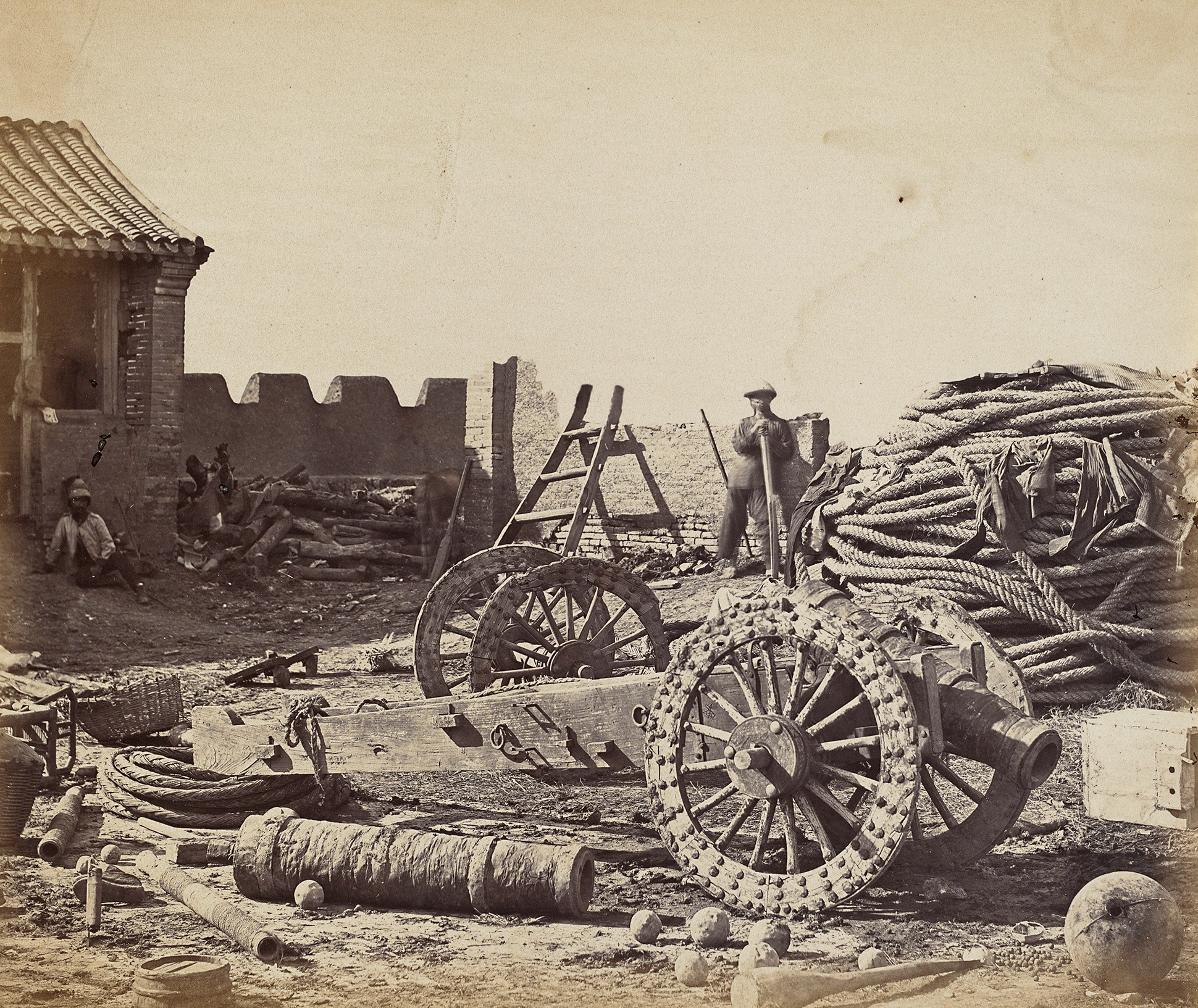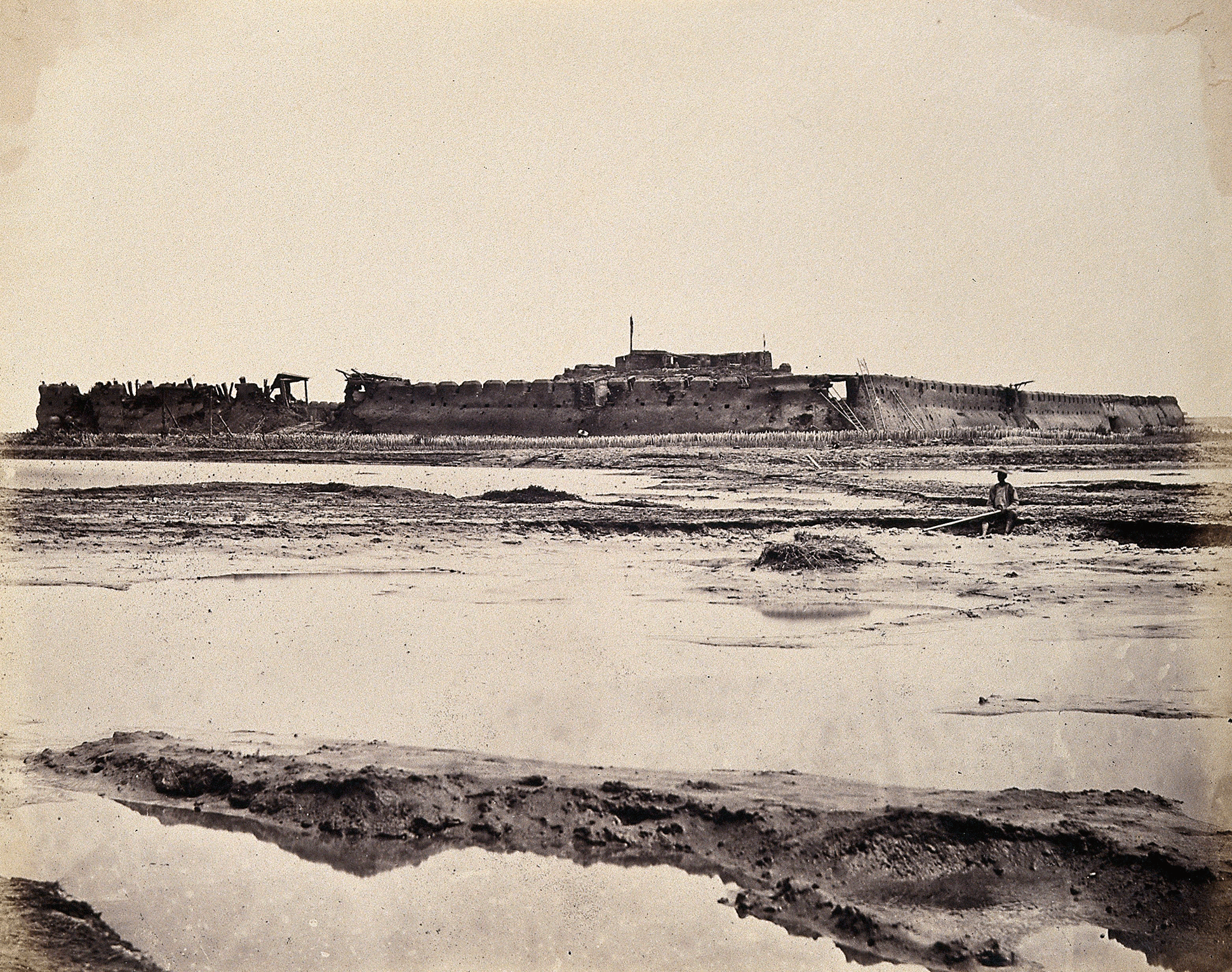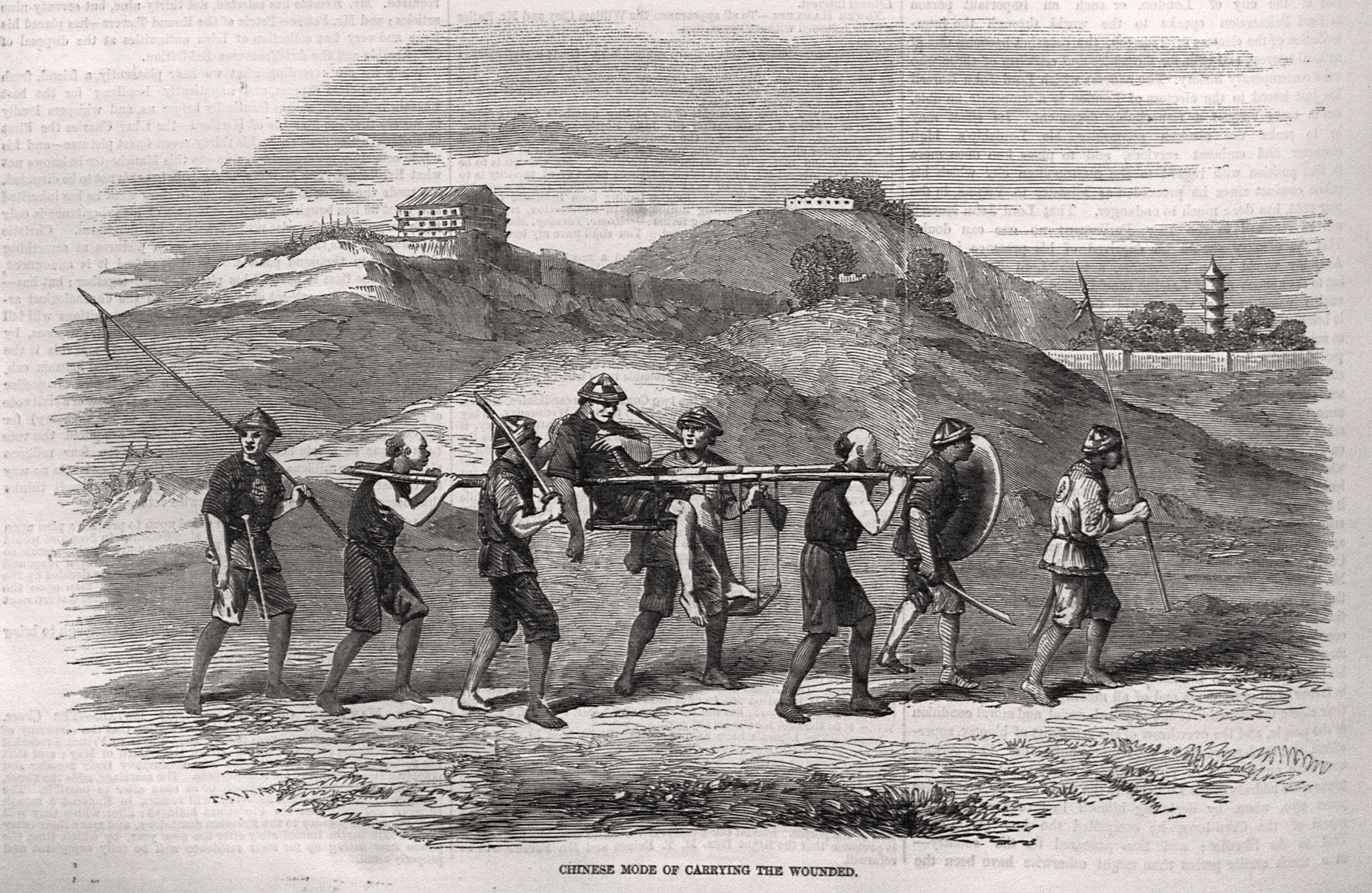| |
BATTLEFIELD VIEWS
Felice Beato and Battlefield Photography
|
|
| |
Advocates of the new technology of photography claimed that it brought an objective description of reality, but the ideology of imperialism still prevented an honest exposure of the human damage of war.
Felice Beato (1832–1909) was one of the first to photograph war on a large scale. Several early photographers had gone to wars in India, and the first official British war photography, depicting the Crimean War, was published in the Illustrated London News. Beato went first to the Crimea, then photographed the aftermath of the Indian rebellion of 1857 in Calcutta, including the first photographs of corpses.
Beato arrived in China along with Charles Wirgman, correspondent for the Illustrated London News, in 1860.
The formidable Lieutenant General Sir James Hope Grant, who had distinguished himself in the suppression of the Indian Mutiny, had been appointed commander of the British land forces in China. … Somehow Felix Beato had managed to get himself informally appointed as photographer to the expedition and sailed in the same ship as Grant. (Terry Bennett, History of Photography in China, 1842-1860, Quaritch, 2009, 147)
During the months before the military campaign departed, Beato took photographs of Guangzhou and Hong Kong. Beato produced multi-plate panoramic views, including the arrival of the British forces in Hong Kong: “First Arrival of Chinese Expeditionary Force—Encampment, Kowloon, Hong Kong,” photographed March 18-27, 1860.
|
|

 | |
| |
Beato accompanied the armies when they moved north in June. Troops faced little resistance through Pehtang (Beidang) and Tangkoo (Tung-Ku). The battle for the Taku Forts resulted in a British victory. There, Beato made his most famous war photographs.
|
|
| |
Beato staged a rare scene with multiple figures in the photograph of the “Head-quarter Staff” at Pehtung Fort. The British flag flies overhead and British troops pose in small groups at various outlooks of the fort. The company includes Indian British colonial forces represented by Sikhs. The Chinese flag is lowered on the left, and a Chinese man, possibly of the “Chinese Coolie Corps,” carries water.
|
|
| |
“Bastion of the 'Pehtang' Fort. Surrendered 2nd Augt. 1860,
Head Quarters English Army,” Photograph by Felice Beato,
between August 2–12, 1860
Typewritten caption in bottom left corner:
“Head-quarter Staff, Pehtung Fort, August 1st, 1860”
Wikipedia
[Beato_07-02-a-Pehtang]
|
|
| |
David Harris’ analysis of the photographs in Of Battle and Beauty (1999) suggests that Beato treated the armaments and other elements in the scene as props that he rearranged for another photograph (below), “Interior of Pehtang Fort”:We find the same spoils of war as in the related view—the cannon, a pair of cannon wheels, a large cannon barrel, the shell box, various cannon balls, and even the coils of rope—but these have now been arranged to form a frieze across the foreground of the image. In addition, Beato posed a member of the “Chinese Coolie Corps” against the building, and reclining in the background shadows is one of Lord Elgin’s private secretaries, Henry Loch, who later became first Baron Loch of Drylow (1827-1900), shown seated by the cannon in the foreground of the related photograph. (Harris, p. 29)
|
|
 |
|
| |
“Interior of Pehtang Fort, Showing the Magazine
and Wooden Gun (caption, Harris, p. 56).
Photograph by Felice Beato, August 1, 1860
U.S. National Gallery of Art
[Beato_08-01-a-Pehtang]
|
|
| |
Harris commented on the appearance of the Chinese in Beato’s photographs: In the majority of the photographs Beato made of Canton and Beijing, the Chinese are largely absent and their culture is represented by the mute presence of their architecture … they occupy a passive and incidental position, hovering at the edges. (Harris, p. 27)
Deep mud, which can be observed in some photographs, was a problem for the invading army, slowing the advance of both men and carts to a crawl. The perils of retreat for the Chinese resulted from the sharpened wooden stakes they had installed as a defense. Elgin’s secretary, Henry Loch (pictured in the photos above), described these in his memoir, Personal Narrative of Occurrences During Lord Elgin's Second Embassy to China, 1860.
The principle of the construction was the same in all the forts. They were surrounded by a thick mud wall, pierced, about ten feet from the top, for artillery; jingles were mounted on the upper parapet, which was also loopholed; surrounding the walls, on the inside, were covered buildings resembling in some degree case mates, but they were not shell proof; a high cavalier rose in the centre of the fort, mounting three or four very heavy guns, the embrasures facing seaward, but the guns could be slewed round in any direction: around the outer wall were two, in some cases, three, mud ditches, from twenty to thirty feet broad, full of water, the ground between the ditches being protected by sharp-pointed bamboo stakes driven deep into the earth, and placed so close to each other as not to admit of a person standing between them. The south side of the northern forts rested on the Pei ho, which flowed at the base of the wall. (Loch, p. 82) |
|
 |
| |
“Exterior of North Fort on Peiho River showing English and French entrance, Aug[u]st 21st 1860, Dagu (Taku), China”
Photograph by Felice Beato, August 21 or later, 1860,
The Second Opium War (volume), 1860
Wellcome Collection
[beato_1860-08-21_North_a]
|
|
| |
Beato's battlefield photographs expose the horror of war, the lethal dangers of retreat, and the logistical perils of taking strategic locales such as the fort at Dagu. In the 2010 book, Felice Beato: A Photographer on the Eastern Road (Anne Lacoste, editor), Fred Ritchen wrote of their reception:
|
|
| |
The British and French armies advanced toward Beijing in early September: by the end of the month they were at the city gate. China would be forced to surrender.
|
|
| |
“Top of the wall of Pekin taken possession of on the 21st October 1860 showing the Chinese guns directed against our batteries, Beijing, China: Chinese army guns on the city wall, after capture by the English and French armies during the
Second China War”
. Photograph by Felice Beato, 1860
Wellcome Collection
[Beato_10-21a-guns-Beijing]
|
|
| |
Photographs could not be reproduced in newspapers at the time, but Beato’s images were the basis for drawings that appeared in print.
|
|
| |
“The War in China.—Encampment of British Forces. From photographs by M. Beato taken shortly before the departure of the troops for the Pehtang,”
The Illustrated London News, October 27, 1860, 391
MIT Visualizing Cultures
[ILN_1860-10-27_p391]
|
|
| |
Beato was a master photographer, but his enterprise was a business. Photography shops, focused mainly on portraiture, had sprung up in Hong Kong and other Chinese cities. Many were operated by Chinese photographers such as Lai Afong, John Hing-Qua, and others. Beato sold his pictures to the soldiers on the expedition, and gathered them into albums for sale. Many of these ended up in the homes of the soldiers’ families: they wouldn’t have wanted to see grisly pictures of the dead. Instead, they gazed at souvenirs of exotic travel and reminders of the tremendous power of the British Empire. Beato’s photographs are “thinly veiled propaganda,” not realistic depictions, and the “ideology of empire permeates the photographs at all levels” (Harris 1998, p.19). But they remain the primary archive of visual sources of the war.
Photographing the final stages of the Second Opium War ensured that Felix (born Felice) Beato would be remembered as the most significant war photographer of the nineteenth century. … No other war photographer of Beato’s time could boast of such a portfolio. He assiduously cultivated his connections with the military, relationships which would serve him well throughout his colorful life. (Bennett, p. 141)
Later, Beato established himself in Yokohama, where he produced popular albums depicting a peaceful, traditional Japan.
Sanitizing the War
The popular press in Britain did not emphasize the terrible destruction and loss of life by Chinese. While the Western powers had very few casualties during a war that lasted four years, thousands of Chinese soldiers and civilians died: in the bombing and occupation of Canton, the repeated destruction of the Taku forts, and the remorseless march to Beijing.
The papers produced many images of massive British ships bombarding heavy Chinese forts, and they sometimes indicated the destruction of housing alongside the fortress walls. The Illustrated London News lamented the burning of the foreign factories by the Chinese as the foreign merchants stood by helplessly. It didn't metntion deaths of Chinese due to British bombardment.
| |
 |
| |
“Chinese Mode of Carrying the Wounded”
The Illustrated London News, March 14, 1857, p. 238
MIT Visualizing Cultures
[ILN_1857-03-14_p238_b]
|
|
| |
Lieutenant-General Henry Hope Crealock (1831-1891), who accompanied Beato, made rare sketches of Chinese victims of the war. The annotations to the grim series include “Tartar soldiers impaled on their own defenses (bamboo stakes) while retreating,” “shot at the assault,” and “being struck by a shell in the earthworks,” apparently “drawn on the spot” by an eye witness to these war horrors.
|
|
| |
“Sketches of the Chinese Campaign. Drawn on the spot by Lt. Col. Crealock”
A sheet of sketches showing war defenses and victims during the Chinese Campaign, 1860, China. Tinted lithograph after Lt. Col. Crealock, August 12, 1860
Wellcome Collection
[1860_Victims_LtColCrealock]
|
|
| |
Erasing Destruction: Other Victims
Besides the soldiers defending China, many Chinese civilians perished in the war, but they were mostly invisible in the visual record. The city of Canton, heavily bombarded from the outset, suffered destruction of houses and major fires. The British artist who viewed the destruction of Canton wrote of the “destroying, looting, and burning” by British troops in “Sketches in Canton,” in the Illustrated London News (below, right):
|
|
|





